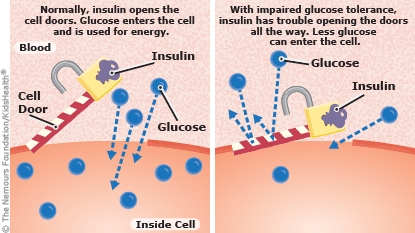Impaired Glucose Tolerance: How to Care for Your Child
Children with impaired glucose tolerance are at higher risk for developing type 2 diabetes. By increasing their physical activity and eating a healthy diet, most kids can reduce this risk.


Glucose (a type of sugar) is the body's major source of energy. Our bodies break down food into glucose and other nutrients, which are then absorbed into the bloodstream from the gastrointestinal tract. A hormone called insulin works like a key to "open" cells so glucose can enter them.
In impaired glucose tolerance, insulin starts losing its ability to "unlock" the cells. Glucose still gets into the cells, but not as efficiently as it should. A person with impaired glucose tolerance doesn't feel ill. But if the problem worsens, it can lead to type 2 diabetes or heart disease.
Impaired glucose tolerance is diagnosed when there is an abnormally high rise in a child's blood glucose level during an oral glucose tolerance test. In this test, a fasting blood glucose test is done after a child has fasted overnight (not eaten for at least 8 hours). Then the child drinks a large amount of glucose, and another blood test is done 2 hours later. A 2-hour blood sugar level of 140–199 indicates impaired glucose tolerance (levels of 200 or higher indicate diabetes).
Health care providers usually order the glucose tolerance test in children who have had an abnormal screening test for possible diabetes (such as a high fasting blood glucose level). Kids who are overweight, have a family history of diabetes, or are from certain ethnic groups are at higher risk for developing impaired glucose tolerance and type 2 diabetes.
By managing their weight, eating a balanced diet, and exercising regularly, most kids with impaired glucose tolerance can avoid diabetes. Medicine may also help in some cases.

-
Give your child any prescribed medicines as directed by your health care provider.
-
If your child is overweight, follow the weight-loss plan prescribed by your health care provider.
-
Limit the amount of fat and sugary foods and drinks in your child's diet.
-
Serve whole grains, vegetables, and other fiber-rich foods.
-
Encourage your child to get at least 150 minutes (2½ hours) of aerobic exercise spread throughout week.


Your child has symptoms of possible diabetes:

Your child:
-
Develops unexplained stomach pain, nausea, or vomiting.
-
Has deep, rapid breathing.
-
Shows extreme drowsiness or confusion, or becomes unconscious.